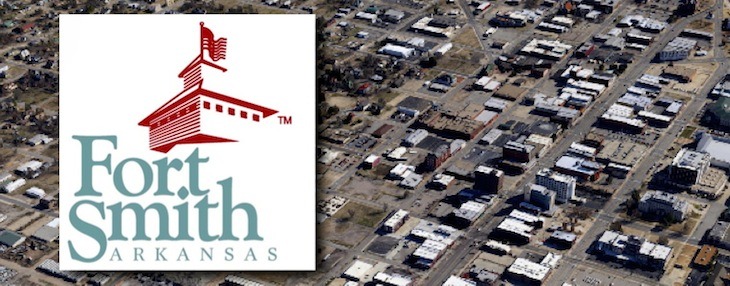Fort Smith Board set to consider naming policy; Director Catsavis comments on removal of park flags
by September 8, 2020 7:18 pm 1,627 views

The Fort Smith Board of Directors on Tuesday (Sept. 8) reviewed a new naming policy for buildings, streets and other infrastructure, but not before City Director George Catsavis took time to push back against claims he was lied to about the removal of flags from a city park.
Fort Smith City Administrator Carl Geffken on Sept. 4 explained that flags at the Riverfront Park in downtown Fort Smith were initially removed because they were faded and tattered. Fort Smith attorney Joey McCutchen has led a Facebook campaign alleging that Geffken’s plan is part of an effort to “cancel our history” because one of the flags removed was the Confederate States of America flag that flew over Fort Smith between 1861 and 1863. Since late 2001, the Fort Smith Parks Department has displayed flags at the Riverfront Park that represented the governments that ruled over what is now Fort Smith.
Geffken did note in the Sept. 4 memo that city officials aren’t sure they will replace the Confederate flag.
“In light of recent racially historic events that have taken place across the country, the City is reconsidering the re-installation of the historical flags and approaching the re-installation plan with sensitivity and empathy for many who find the historical associations with the Confederate flag hurtful or hateful,” Geffken noted.
McCutchen noted in a Sept. 3 Facebook post that he solicited help from Catsavis to figure out why the flags were removed. It was in that post McCutchen said city staff lied to Catsavis.
“I attempted to find out why the flags were removed a couple of months ago by having Director Catsavis find out. He was lied to by city staff. It took at FOIA request to get to the bottom of this attack on our city, state and national history,” McCutchen noted.
Catsavis said at Tuesday’s study session he wanted to clarify what happened.
“Somehow this turned into I was lied to by people at the city, which never happened. I just want to make that clear. I’ve never been lied to by anybody at the city. … This got blown out of proportion, I think,” Catsavis said.
He also said he never submitted a Freedom of Information Act (FOIA) request to the city for documents about removal of the flags.
“I don’t know why Mr. McCutchen would twist that into saying George was lied to, when I wasn’t. I was told the truth,” he said, adding he was “upset” that McCutchen dragged him into the issue.
McCutchen denied that he twisted Catsavis’ comments.
“I did not twist the words of George Catsavis as my Facebook post clearly shows. When city staff told George that ‘flags where taken down because they were damaged.’ I believed that to be a half truth and/or lie when George told it to me and I still believe it is a lie/half truth today. The emails I FOIA’ed and received prove just that. I never inferred or said whether George thought it was a lie and/halftruth. I did not want or need to know his opinion in that regard,” McCutchen said in a note to Talk Business & Politics. “I later sent a FOiA request which documents confirm my suspicions. My FOIA inquiry was not about flag removal but rather about the monument. I have sent an additional FOIA on the flag removal and we shall see what that uncovers. Emails that I already have show that Carl Geffken had made the decision to remove at least 2 flagpoles in mid-late June. The confederate flagpole was most certainly one of the 2, although Mr Geffken never discussed it publicly to my knowledge. Don’t we the people deserve transparency?”
RENAMING POLICY
A draft of the revised naming policy sent from Geffken to the director notes that the “renaming of streets is strongly discouraged.”
“Efforts to change the name of a street should be subject to the most critical examination due to factors related to commerce, public safety response, cost to the public for implementing the name change, and other economic implications or hardships to property owners along the street that might be associated with changing address designations,” according to the revised language.
Factors to be revised by the city administrator, according to the proposed revisions, include:
• The number of properties, parcels, structures and/or addresses that would be affected by changing the name of the street;
• The number of intersections along the street that would require replacement of street signage and the estimated cost of materials and labor to make and install new signs to reflect the name change; and
• Any issues regarding changing the street name in the 9-1-1 address database should be identified.
Following a review, the city administrator would then recommend to the board if the street name should change or remain the same.
“If the Board determines the name change should move forward, such decision shall be publicized in a local newspaper for at least a two-week period and citizen comments shall be requested. The Board shall consider all public comments received. At any time following the two-week public notice period and after considering all public comments received, the Board may finalize the decision regarding renaming the street,” notes the revised policy.
Mayor George McGill advised Tuesday the city should should look at state policy which he said is thorough, because a voting body should be sure that a name used does not have to be taken down. Director Kevin Settle asked for a four-week public notice process instead of two weeks to give the public more of a comment period. Director Lavon Morton said the revised policy should make it clear that the board may also initiate – in addition to the citizen process – naming and renaming.
The new policy will be considered by the board during its first regular meeting in October.
